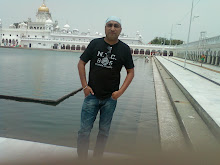SAHIBZADAS ZORAWAR SINGH AND FATEH SINGH
Sahibzada Zorawar Singh was born on 17 November 1696 and Sahibzada Fateh Singh on 25 February 1699. After the tragic death of their mother Mata Jito-ji (5 Dec 1700) they were brought up under the care of their grandmother Mata Gujri Ji. Both the princes were closely attached to their grandmother. Mata Gujari took charge of both the princes as the column moved out of Anadpur.
As Guru Gobind Singh evacuated Anandpur on the night of 5 December 1705, he was pursued by the host. In front ran the river Sarsa, swollen with rain water. Under cover of a quick rearguard action fought on the river bank, the Guru, his brave Sikhs and his family succeeded in crossing the Sarsa. Unfortunately, in the commotion of confused cries in the dark, Mata Gujri and the two younger Sahibzade, along with their cook, Gangu, were separated from the Guru and his band. Not knowing where to go Gangu offered to shelter them at his house in village Kheri, now known as Saheri, near Morinda. The journey being hazardous and dark they reached Kheri the following night. Tired and hungry they were asked to rest in the attic. But Gangu proved deceitful. During the night Gangu stole Mata Gujri’s saddlebag containing cash and valuables. In the hope of a reward from the government he spied on them. With the help of the village headman he betrayed them to Jani Khan and Mani Khan, the Ranghar officials of Morinda. The latter took Mata Gujri and the two Sahibzade into custody and in the morning despatched them to Sirhind where they were confined in the Cold Tower - Thanda Burj - of the Fort.
On the morning of 9 December 1705 Zorawar Singh and Fateh Singh, aged 9 and 7 respectively, were summoned before the faujdar, Nawab Wazir Khan. Wazir Khan tried to lure the Sahibzade to embrace Islam with promises of riches and honours. But the brave and fearless sons of Guru Gobind Singh spurned the suggestion. He then threatened them with death but they remained undaunted. Nawab Sher Muhammad Khan, a high ranking officer and chief of Malerkotla, who was also present in the court, intervened for the innocent children to be spared their lives; to be given some more time to ponder over the suggestion to convert. As a result the two Sahibzade spent another two days of severe winter in their grandmother’s lap in the Cold Tower. Still adamant as ever, on 11 December 1705
Nawab Wazir Khan ordered their death by bricking them alive. Nawab Sher Muhammad Khan pleaded against the death sentence on the grounds that the boys were too young to be given such a harsh penalty. They could not, in any case, be held responsible for the actions of their father. As Wazir Khan began to waver at the just reproof of his peer, Suchchanand put in a remark "The progeny of a serpent shall grow up as serpents, and should therefore be shown no mercy." Wazir Khan was encouraged by these words and thereupon reiterated his order for the children to be bricked alive in a wall. By Divine Will, as the masonry around their tender bodies reached chest high, it crumbled. Wazir Khan’s anger at this failure ordered the princes back to the Cold Tower for another night. The next day, 12 December 1705, the Sahibzade were once again offered the choice to convert to Islam or face death by execution. The brave Sahibzade chose the latter and were executed. The aged Mata Gujri, who had all along been kept in the Cold Tower, only a short distance away, breathed her last as the news of the execution reached her ears.
After the death of Mata Gujri and the two Sahibzade, Seth Todar Mall, a wealthy merchant and an influential citizen of Sirhind, made arrangements to perform the last rites. But no one would give him a patch of land in the locality to be used as cremation ground. Then one Chandhari Atta, a local resident, agreed to sell him a small plot. He stipulated that Todar Mall could take only as much land as he could cover with gold nuggets, mohran. The Seth produced the mohran and bought the piece of land he needed. After the cremation a Sikh, Jodh Singh, of village Attevali buried the ashes.
Sirhind suffered a full fury of Sikh ire when Banda Singh Bahadur marched upon it with his daring host. Wazir Khan was killed. Diwan Suchchanand, who explicitly championed the penalty laid upon the young Sahibzade, was captured and killed. Sirhind and the Fort were razed to the ground. A memorial was erected marking the spot where the two princes were executed. In 1764 Maharaja Karam Singh of Patiala built the Gurdwara Fatehgarh on the site and ordered to search for and determine the exact spot where the three were cremated. At the spot, in 1843, the Gurdwara Joti Sarup was built. In 1888 Giani Thakar Singh started the annual Jor-Mela (fair) held during the last week in December to commemorate the martyrdom of Guru Gobind Singh’s mother, Mata Gujri Ji, and his two sons Sahibzadas Zorawar Singh and Fateh Singh. A century later, in 1944, Maharaja Yadavinder Singh set up a committee for the improvement of Gurdwara Fatehgarh Sahib and Gurdwara Joti Sarup Sahib. Today Gurdwara Fatehgarh, with all the affiliated shrines, is administered directly by Shiromany Gurdwara Parbandhak Committee.

No comments:
Post a Comment